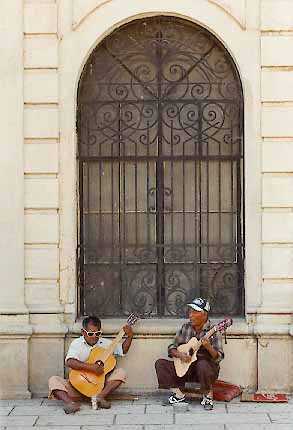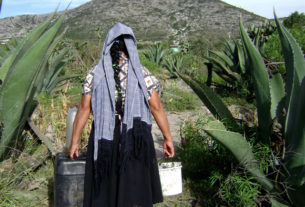
A first visit to Oaxaca, capital of Mexico’s southern state of Oaxaca, should begin at the zócalo, the town plaza. There’s always something going on there, for Oaxaca is a town of festivals: the Night of the Radishes on December 23, where farmers display fantastically carved giant radishes; the Festival of Lunes del Cerro (Monday of the Hill) in July, featuring guelaguetza dancers; the Day of the Dead, the Mexican’s Halloween, on November 2. In December, if you buy a buñuelo, a kind of fried pancake sold at the zócalo, you get to break the plate. On New Year’s Eve and at all the festivals, the heavens are ablaze in brilliant fireworks.
If no festival is in the offing, find a table in one of the plaza’s arcades and enjoy the incredible parade of humanity passing before you: Mexican families on promenade, Zapotec and Mixtec vendors hawking their wares, post-adolescents from the United States in bizarre get-ups. You don’t have to leave your table to buy something, for the vendors will come to you, with rebozos, native dresses, flowers, balloons, wooden toys and onyx animals. Several nights a week the state marimba plays at the zócalo, and in December there are nightly folkloric dances at the nearby Hotel Monte Albán.
Oaxaca is a great walking city, for everywhere you turn there are captivating vistas and architectural delights. At the zócalo you’ll find the arcaded Palace of the Governors and the 16th-century cathedral, and on nearby Independencia Street, the plush Macedonian Theater. The Rufino Tamayo Museum, in a former palace on Morelos, houses the artist’s fine collection of pre-Columbian statuary, including the much reproduced yippy dogs from Colima. The Camino Real Hotel, on Cinco de Mayo Street, without a doubt Mexico’s most beautiful hotel, was built in the 16th century as a Dominican convent and has also served as town jail and city hall. Stop by to reconnoiter — you’ll have fun getting lost in the hotel’s mazelike frescoed courtyards.
Of Oaxaca’s twenty-seven churches, by far the most opulent is the Santo Domingo de Guzmán, built by Indian artisans in the 16th and 17th centuries and displaying much gold leaf. Behind it, in a former monastery, is the Regional Museum of Oaxaca, housing a fine collection of native costumes and the incredible gold Mixtec jewelry and other objects found in Tomb 7 of Monte Albán, the ancient Zapotec city of the gods carved out of a mountaintop above Oaxaca.
Once you feel you’ve “done” the town, it’s time to trek out to the Indian villages and the pre-Hispanic monuments. The best time to visit Monte Alban, reached by winding road six miles above the city, is early in the morning, when it’s still cool. With its grand scheme of plazas and pyramids, observatory, ball court and tombs, Monte Albán is indeed impressive — it’s reason enough to visit Oaxaca.
Two other delightful villages are San Bartolo Coyotepec, where the famous unglazed black pottery is produced, and Arrazola, home of the alebrijes — antastically carved wooden animals in the shapes of cats, dogs, jaguars, armadillos, griffins, whatever. In the ten years since I started visiting Oaxaca, the animals have proliferated and become more elaborate, and now can be found all over the city. They’ve also brought a great deal of prosperity to the village of Arrazola. There are additionally more ruins to explore: Yagul, Zaachila, Lambityeco, and Dainzu; and Indian markets — the largest in the Americas congregates on Saturdays in the city, and every village has its market day. The best way to reach these attractions outside the city is by cab, with a bonded guide.
As to lodging choices, the most popular hotel in Oaxaca is of course the Camino Real. Another good choice is the bungalow-style Victoria on the hill. But my favorite has always been the Casa Colonial on Miguel Negrete, a pleasant 1529 hacienda-style American-run inn where guests gather at set times for meals and you’re likely to meet a fascinating assortment of people.
You’ll never run out of things to do in Oaxaca, but when you begin to grow weary of city life, you’ll be ready to take the air taxi flight or drive to Puerto Escondido, the quaint fishing village on the Oaxacan coast. But that calls for another article!

